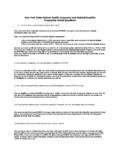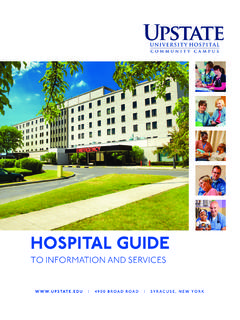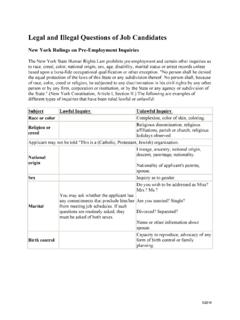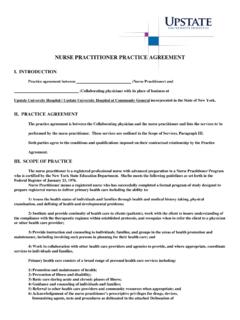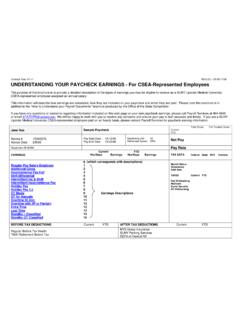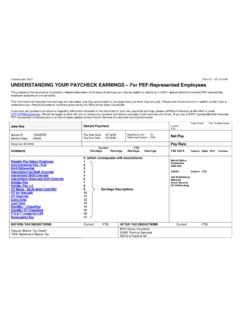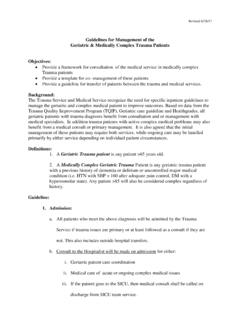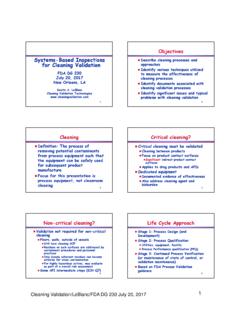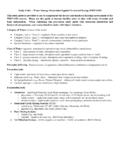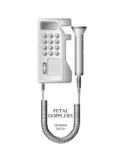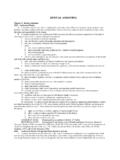Transcription of Self Study Syllabus - Upstate Medical University
1 IC Syllabus revised 1 Self- Study Syllabus Revised 2006, 2008,2009,2013,2016 This self- Study Syllabus was developed by the Infection Control Professionals from Chapter 118, the Heart of New York Chapter, of the Association for Professionals in Infection Control and Epidemiology IC Syllabus revised 2 TABLE OF CONTENTS Element Title ELEMENT I Professional Responsibility for Infection Prevention ELEMENT II Transmission and Control of Infection In Health Care Settings ELEMENT III Use of Engineering and Work Practice Controls To Reduce The Opportunity For Patient And Health Care Worker Exposure To Potentially Infectious
2 Material ELEMENT IV Selection and Use of Barriers and Personal Protective Equipment ELEMENT V Principles and Practices for Cleaning, Disinfection and Sterilization ELEMENT VI Prevention and Control of Infectious and Communicable Diseases In Health Care Workers ELEMENT VII Ongoing Topics In Infection Prevention (MDRO s: Methicillin Resistant Staphylococcus Aureus (MRSA), Vancomycin Resistant Enterococci (VRE), Clostridium Difficile ( ), Multi-Drug Resistant Tuberculosis (MDRTB), Extended Spectrum Beta-Lactamase (ESBL), Carbapenemum Resistant Enterobacteriaceae (CRE), Also Severe Acute Respiratory Syndrome (SARS), Creutzfeld Jacob Disease, Ebola Virus Disease (EVD), Zika Virus, and Bioterrorism,)
3 ELEMENT VIII Infection Prevention As Applied To Nursing Homes and Long Term Care Facilities ELEMENT IX H1N1 Past, Present and Future REFERENCES IC Syllabus revised 3 ELEMENT I PROFESSIONAL RESPONSIBILITY FOR INFECTION PREVENTION All health-care professionals share responsibility to adhere to scientifically accepted principles and practices of infection prevention, and to monitor the performance of those for whom they are responsible.
4 Learning Objectives: Recognize benefits to patients and health-care workers of adhering to scientifically accepted principles and practices of infection prevention; Recognize the professional s responsibility to adhere to these practices, and the consequences of failing to comply; Recognize the professional s responsibility to monitor infection prevention practices of persons for whom he/she is responsible Definitions: Standard Precautions: precautions that are applicable to all patients, including use of barriers, such as gloves, gowns, masks, and/or protective eye wear, and proper disposal of sharps, to prevent skin and mucous membrane exposure to blood borne pathogens from blood, all body fluids, secretions and excretions regardless of whether or not they contain visible blood.
5 Standard of Care: established criteria for the performance of individuals in similar circumstances. OSHA: Occupational Safety and Health Administration, a branch of the Department of Labor I. Standards of care in infection prevention A. Standard Precautions are used to reduce the risk of transmission of microorganisms from both recognized and unrecognized sources in hospitals; this is the first level of precautions for all patients. B. Transmission based precautions, the second level of precautions used for caring for patients with or suspected to have certain communicable diseases.
6 1. Airborne 2. Contact 3. Droplet C. Hand washing and aseptic technique, practices to prevent contact spread of most bacterial infections ( staph and strep) and some viruses (herpes, cold viruses, CMV) in healthcare settings. D. Appropriate cleaning, disinfection, and sterilization processes of Medical devices and equipment to prevent transmission of infection. E. Occupational health practices used for the prevention and control of communicable diseases in health-care workers. IC Syllabus revised 4 II.
7 Standards of professional conduct as they apply to infection prevention A. Mandated NY State and Federal standards of professional conduct 1. New York State: 1992 legislation formally established scientifically accepted infection prevention practices as standards of professional conduct. The New York state Department of Health and New York State Education Department require that all licensed health care professionals in New York must complete mandatory course work in infection prevention before July 1, 1994 and every 4 years thereafter. Documentation of this training is required for hospital-credentialing of physicians, and for state licensing or registration of non-physicians.
8 2. OSHA (US Department of Labor): in 1991 the OSHA Blood borne Pathogens Standard took effect, requiring enforcement of Universal/ Standard Precautions and training of all personnel (with potential blood or body fluid exposure) in infection prevention techniques. The Standard also mandates the availability of appropriate protective equipment and barriers, and requires procedures for follow up after an exposure. B. Implications of professional conduct standards 1. All health care professionals bear responsibility to adhere to infection prevention standards. By law in New York State, unprofessional conduct includes failing to use scientifically accepted infection prevention techniques appropriate to each profession for the cleaning and sterilization or disinfection of instruments, devices, materials, and work surfaces, utilization of protective garb, use of covers for contamination-prone equipment and the handling of sharp instruments.
9 And failure to sue scientifically accepted infection prevention practices to prevent transmission of disease pathogens from patient to patient, professional to patient, employee to patient, and patient to 2. All health-care professionals have a responsibility to monitor the practices of others to assure the safety of all patients and personnel. 3. Consequences of failure to follow accepted standards of infection prevention include: a. Subjecting self, co-workers, and/or patients to increased risk of communicable disease. b. Subjecting oneself to charges of unprofessional conduct.
10 I. Mechanisms for reporting unprofessional conduct: patients, family members, or co-workers can file charges against a health professional through their institution ( , hospital or employer) or directly to the New York State Department of Health, Office of Health Systems Management (OHSM); ii. Investigation of the complaint is carried out by the hospital, employer, or OHSM; iii. Possible outcomes, depending on the severity of misconduct, include: IC Syllabus revised 5 Disciplinary action Revocation of professional license, or Professional liability: since infection prevention practices are considered standard of care, failure to adhere to these standards may be grounds for professional liability.
